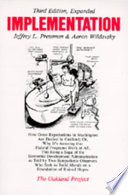
Implementation
By - Pressman, Jeffrey L , Wildavsky, Aaron B
Floor
-
Floor 1
Published
-
University of California Press, Berkeley, [1973]
ISBN 10 - 0520053311
ISBN 13 - 9780520053311
Book Status
-
1 Qnty Available with us.
Shelf No
-
18
common.call_no
-
353.0084 PRE 1984
call number :353.0084 PRE 1984